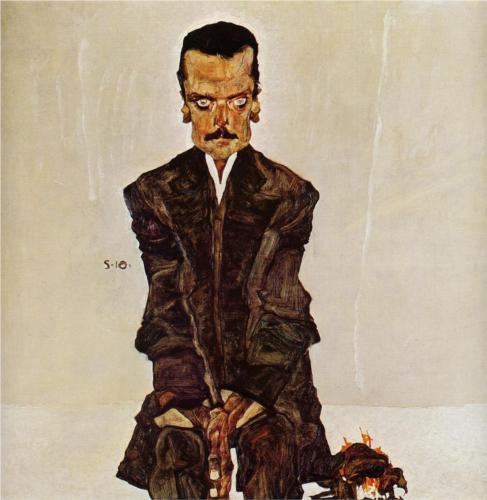Expressionism
Art up until the 20th century was about practicality and capturing accurate, detailed depictions of reality. Conversely, The Expressionist art movement was the opposite (Expressionism, 1993). Expressionist’s sought to convey the emotions associated with their subjects as they, the artists, felt them. For example, colors were bolder, brush strokes were more vivid, and artists essentially altered images as they painted them to depict subjective feelings associated with them. In that regard, the expressionist movement was revolutionary; it was a more personal, individual art style that gave artists much more freedom in expression (Encyclopedia Britannica, 2014).
 Douple Self-Portrait
Douple Self-Portrait
by Ernst Ludwig Kirchner, used under ![]()
The expressionist movement was essentially a reaction against its predecessor, impressionism. The movement laid its roots in Germany, when an artist named Ernst Ludwig Kirchner and a group of artists began experimenting with their paintings. They wanted their paintings to reflect the intensity and passion that art was missing at that time (Encyclopedia Britannica, 2014). Expressionist paintings can vary from the slightly distorted to the very surreal. A majority of expressionist paintings have a subject focus, usually a person or a group of people. The themes of expressionist paintings can range from subjects carrying out everyday tasks to depictions of death claiming people, as expressionist Käthe Kollwitz often depicted. Subjects were not limited to people, however. Expressionist Franz Marc, for example, was known for his paintings of animals.

Blue Horse I
by Franz Marc, used under ![]()
Expressionists were heavily influenced by the paintings of Vincent van Gogh and Edvard Munch. Some of the most famous Expressionists include Oskar Kokoschka, Egon Schiele, and Käthe Kollwitz (Encyclopedia Britannica, 2014).

Portrait of the Publisher Eduard Kosmack
by Egon Schiele, used under ![]()
Expressionism is evident in this painting by Egon Schiele by looking at the distortions in the subject’s eyes, demeanor, and hands. Such characteristics can help the viewer infer the feelings Schiele wanted to evoke.
Bibliography
Encyclopedia Britannica. (n.d.). Expressionism. Retrieved 3 27, 2014, from Britannica: http://britannica.com/EBchecked/topic/198740/Expressionism
Expressionism. (1993). In Bloomsbury guide to human thought. Retrieved from https://ezproxy.butler.edu/login?qurl=http%3A%2F%2Fsearch.credoreference.com%2Fcontent%2Fentry%2Fbght%2Fexpressionism%2F0
Kirchner, E.L. (1914). Douple Self-Portrait. [Painting]. Retrieved from www.wikipaintings.org/en/ernst-ludwig-kirchner/douple-self-portrait. Public domain image.
Marc, F. (1911). Blue Horse I. [Painting]. Retrieved from www.wikipaintings.org/en/franz-marc/blue-horse-i-1911. Public domain image.
Schiele, E. (1910). Portrait of the Publisher Eduard Kosmack. [Painting]. Retrieved from www.wikipaintings.org/en/egon-schiele/portrait-of-the-publisher-eduard-kosmack-1910. Public domain image.
